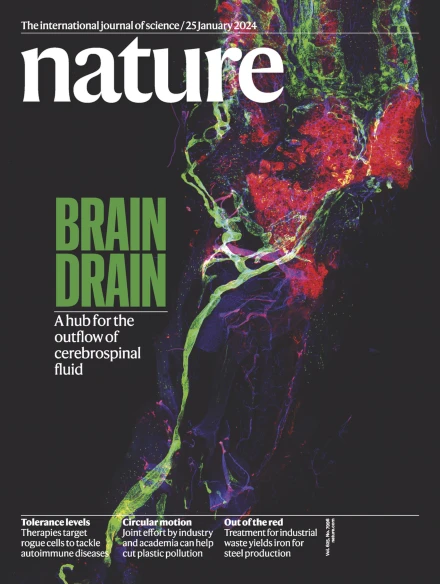Fanzor is a eukaryotic programmable RNA-guided endonuclease
IF 50.5
1区 综合性期刊
Q1 MULTIDISCIPLINARY SCIENCES
引用次数: 15
Abstract
RNA-guided systems, which use complementarity between a guide RNA and target nucleic acid sequences for recognition of genetic elements, have a central role in biological processes in both prokaryotes and eukaryotes. For example, the prokaryotic CRISPR–Cas systems provide adaptive immunity for bacteria and archaea against foreign genetic elements. Cas effectors such as Cas9 and Cas12 perform guide-RNA-dependent DNA cleavage1. Although a few eukaryotic RNA-guided systems have been studied, including RNA interference2 and ribosomal RNA modification3, it remains unclear whether eukaryotes have RNA-guided endonucleases. Recently, a new class of prokaryotic RNA-guided systems (termed OMEGA) was reported4,5. The OMEGA effector TnpB is the putative ancestor of Cas12 and has RNA-guided endonuclease activity4,6. TnpB may also be the ancestor of the eukaryotic transposon-encoded Fanzor (Fz) proteins4,7, raising the possibility that eukaryotes are also equipped with CRISPR–Cas or OMEGA-like programmable RNA-guided endonucleases. Here we report the biochemical characterization of Fz, showing that it is an RNA-guided DNA endonuclease. We also show that Fz can be reprogrammed for human genome engineering applications. Finally, we resolve the structure of Spizellomyces punctatus Fz at 2.7 Å using cryogenic electron microscopy, showing the conservation of core regions among Fz, TnpB and Cas12, despite diverse cognate RNA structures. Our results show that Fz is a eukaryotic OMEGA system, demonstrating that RNA-guided endonucleases are present in all three domains of life. Fanzor is shown to be an RNA-guided DNA endonuclease, demonstrating that such endonucleases are found in all domains of life and indicating a potential new tool for genome engineering applications.

Fanzor 是一种真核生物可编程 RNA 引导的内切酶
RNA 引导系统利用引导 RNA 与目标核酸序列之间的互补性来识别遗传因子,在原核生物和真核生物的生物过程中发挥着核心作用。例如,原核生物的 CRISPR-Cas 系统为细菌和古细菌提供了对外来遗传因子的适应性免疫。Cas9 和 Cas12 等 Cas 效应器执行依赖于向导 RNA 的 DNA 切割1。尽管已经研究了一些真核生物 RNA 引导系统,包括 RNA 干扰2 和核糖体 RNA 修饰3,但真核生物是否存在 RNA 引导的内切酶仍不清楚。最近,一类新的原核生物 RNA 引导系统(称为 OMEGA)被报道4,5。OMEGA 效应子 TnpB 可能是 Cas12 的祖先,具有 RNA 引导的内切酶活性4,6。TnpB 也可能是真核生物转座子编码的 Fanzor(Fz)蛋白的祖先4,7,这就提出了真核生物也配备有 CRISPR-Cas 或类似 OMEGA 的可编程 RNA 引导内切酶的可能性。在这里,我们报告了 Fz 的生化特性,表明它是一种 RNA 引导的 DNA 内切酶。我们还表明,Fz 可被重新编程,用于人类基因组工程应用。最后,我们利用低温电子显微镜在 2.7 Å 处解析了 Spizellomyces punctatus Fz 的结构,表明尽管同源 RNA 结构各不相同,但 Fz、TnpB 和 Cas12 之间的核心区域保持一致。我们的研究结果表明,Fz 是真核生物的 OMEGA 系统,证明 RNA 引导的内切酶存在于生命的所有三个领域。Fanzor 被证明是一种 RNA 引导的 DNA 内切酶,这表明这类内切酶存在于所有生命领域,并为基因组工程应用提供了一种潜在的新工具。
本文章由计算机程序翻译,如有差异,请以英文原文为准。
求助全文
约1分钟内获得全文
求助全文
来源期刊

Nature
综合性期刊-综合性期刊
CiteScore
90.00
自引率
1.20%
发文量
3652
审稿时长
3 months
期刊介绍:
Nature is a prestigious international journal that publishes peer-reviewed research in various scientific and technological fields. The selection of articles is based on criteria such as originality, importance, interdisciplinary relevance, timeliness, accessibility, elegance, and surprising conclusions. In addition to showcasing significant scientific advances, Nature delivers rapid, authoritative, insightful news, and interpretation of current and upcoming trends impacting science, scientists, and the broader public. The journal serves a dual purpose: firstly, to promptly share noteworthy scientific advances and foster discussions among scientists, and secondly, to ensure the swift dissemination of scientific results globally, emphasizing their significance for knowledge, culture, and daily life.
 求助内容:
求助内容: 应助结果提醒方式:
应助结果提醒方式:


